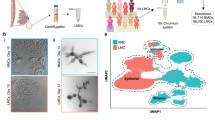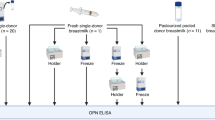Abstract
Erythropoietin (Epo) is a normal constituent of human milk, but the origin and fate of this cytokine in milk are not known. Regarding its origin, we hypothesized that cells of the mammary gland secrete Epo into milk actively and, therefore, that concentrations in milk do not correlate with concentrations in serum. Regarding its fate, we hypothesized that Epo concentrations in milk change with time postpartum and that Epo in milk is protected from digestion in the neonatal gastrointestinal tract. To address these issues, we measured Epo concentrations in 103 milk samples (ELISA), 55 of which were paired with serum. Mammary duct epithelial cells were evaluated as a source of Epo by breast tissue immunohistochemistry and by cell culture. Circulating and milk Epo were compared by Western analysis to detect size differences, possibly reflecting differences in processing. Epo stability in simulated conditions of digestion was evaluated. We observed that milk Epo concentrations increase as a function of duration of breast-feeding and have a negative correlation with serum Epo or milk protein concentration. Mammary duct epithelial cells from breast biopsies of lactating women had marked immunoreactivity to Epo, but such activity was minimal to absent in nonlactating breast tissue. Further evidence that mammary duct epithelia produce Epo was obtained by observing Epo mRNA and protein expression in cultured human mammary epithelial cells. The molecular size of Epo in milk and serum is identical. Recombinant Epo added to human milk or commercial infant formulas was relatively stable in conditions that simulate gastric and small intestinal conditions of newborn infants; however, recombinant Epo added to D5W was not protected from digestion. We conclude that Epo concentrations in milk increase as a function of the duration of breast feeding, that Epo is actively secreted into human milk by mammary duct epithelia, and that the Epo within milk is largely protected from digestion.
Similar content being viewed by others
Log in or create a free account to read this content
Gain free access to this article, as well as selected content from this journal and more on nature.com
or
Abbreviations
- Epo:
-
erythropoietin
- Epo-R:
-
erythropoietin receptors
- GI:
-
gastrointestinal
- HMEC:
-
human mammary epithelial cells
- rEpo:
-
recombinant erythropoietin
References
Kling PJ, Sullivan TM, Roberts RA, Philipps AF, Koldovsky O 1998 Human milk as a potential enteral source of erythropoietin. Pediatr Res 43: 216–221
Juul SE, Yachnis AT, Christensen RD 1998 Tissue distribution of erythropoietin and erythropoietin receptor in the developing human fetus. Early Hum Dev 52: 235–249
Juul SE, Joyce AE, Zhao Y, Ledbetter DJ 1999 Why is erythropoietin present in human milk? Studies of erythropoietin receptors on enterocytes of human and rat neonates. Pediatr Res 46: 263–268
Okada A, Kinoshita Y, Maekawa T, Hassan MS, Kawanami C, Asahara M, Matsushima Y, Kishi K, Nakata H, Naribayashi Y, Chiba T 1996 Erythropoietin stimulates proliferation of rat-cultured gastric mucosal cells. Digestion 57: 328–332
Clapp JF III, Little KD, Appleby-Wineberg SK, Widness JA 1995 The effect of regular maternal exercise on erythropoietin in cord blood and amniotic fluid. Am J Obstet Gynecol 172: 1445–1451
Richey SD, Ramin SM, Bawdon RE, Roberts SW, Dax J, Roberts J, Gilstrap LC 1995 Markers of acute and chronic asphyxia in infants with meconium-stained amniotic fluid. Am J Obstet Gynecol 172: 1212–1215
Carmichael RD, LoBue J, Gordon AS 1992 Neonatal erythropoiesis. I. Peripheral blood erythropoietic parameters: data suggest erythropoietin transfer via maternal milk. Endocr Regul 26: 83–88
Carmichael RD, LoBue J, Gordon AS 1992 Neonatal erythropoiesis. II. Bone marrow and splenic erythropoietic activity: data suggest erythropoietin transfer via maternal milk. Endocr Regul 26: 143–149
Juul SE, Ledbetter DJ, Joyce AE, Zhao Y, DeMarco V 1999 Why is erythropoietin in mothers milk? Is it enterally absorbed?. Pediatr Res 45: 156Aabstr
Britton JR, Christensen RD 1995 Enteral administration of recombinant erythropoietin to preterm infants. J Perinatol 15: 281–283
Ballin A, Bilker-Reich A, Arbel E, Davidovitz Y, Kohelet D 1999 Erythropoietin, given enterally, stimulates erythropoiesis in premature infants. Lancet 353: 1849
Juul SE, Anderson DK, Li Y, Christensen RD 1998 Erythropoietin and erythropoietin receptor in the developing human central nervous system. Pediatr Res 43: 40–49
Martin VV, Nock S, Meyer-Gauen G, Hager KP, Jensen U, Cerff R 1993 A method for isolation of cDNA-quality mRNA from immature seeds of a gymnosperm rich in polyphenolics. Plant Mol Biol 22: 555–556
Lebenthal E, Siegel M 1985 Understanding gastric emptying: implications for feeding the healthy and compromised infant. J Pediatr Gastroenterol Nutr 4: 1–3
Yahav J, Carrion V, Lee PC, Lebenthal E 1987 Meal-stimulated pepsinogen secretion in premature infants. J Pediatr 110: 949–951
Rodriguez A, Castro FO, Aguilar A, Ramos B, Del Barco DG, Lleonart R, De la Fuente J 1995 Expression of active human erythropoietin in the mammary gland of lactating transgenic mice and rabbits. Biol Res 28: 141–153
Okajima Y, Matsumura I, Nishiura T, Hashimoto K, Yoshida H, Ishikawa J, Wakao H, Yoshimura A, Kanakura Y, Tomiyama Y, Matsuzawa Y 1998 Insulin-like growth factor-I augments erythropoietin-induced proliferation through enhanced tyrosine phosphorylation of STAT5. J Biol Chem 273: 22877–22883
Yasuda Y, Masuda S, Chikuma M, Inoue K, Nagao M, Sasaki R 1998 Estrogen-dependent production of erythropoietin in uterus and its implication in uterine angiogenesis. J Biol Chem 273: 25381–25387
Carmichael RD, Gordon AS, Lobue J 1986 Effects of the hormone erythropoietin in milk on erythropoiesis in neonatal rats. Endocrinol Exp 20: 167–188
Juul SE, Zhao Y, Dame C 2000 The effects of enteral versus parenteral recombinant erythropoietin on bowel growth. Pediatr Res 47: 971Aabstr
Acknowledgements
The authors thank Dr. Raymond Hackett for his assistance in obtaining and interpreting the breast biopsy specimens and General Clinical Research Center Scatterbed nurses Pam Connolly and Ann Cothran for their assistance in obtaining milk, blood, and gastric juice specimens.
Author information
Authors and Affiliations
Additional information
Supported by CAP award RR-00082 from the National Institutes of Health and by a grant from the Children's Miracle Network.
Rights and permissions
About this article
Cite this article
Juul, S., Zhao, Y., Dame, J. et al. Origin and Fate of Erythropoietin in Human Milk. Pediatr Res 48, 660–667 (2000). https://doi.org/10.1203/00006450-200011000-00018
Received:
Accepted:
Issue date:
DOI: https://doi.org/10.1203/00006450-200011000-00018
This article is cited by
-
Robust increases in erythropoietin production by the hypoxic fetus is a response to protect the brain and other vital organs
Pediatric Research (2018)
-
Increased yet iron-restricted erythropoiesis in postpartum mothers
Annals of Hematology (2012)
-
Erythropoietin modulates the neural control of hypoxic ventilation
Cellular and Molecular Life Sciences (2009)



